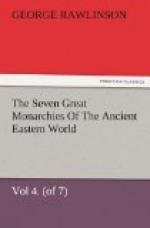In its general character the Babylonian Empire was little more than a reproduction of the Assyrian. The same loose organization of the provinces under native kings rather than satraps almost universally prevailed, with the same duties on the part of suzerain and subjects and the same results of ever-recurring revolt and re-conquest. Similar means were employed under both empires to check and discourage rebellion—mutilations and executions of chiefs, pillage of the rebellious region, and wholesale deportation of its population. Babylon, equally with Assyria, failed to win the affections of the subject nations, and, as a natural result, received no help from them in her hour of need. Her system was to exhaust and oppress the conquered races for the supposed benefit of the conquerors, and to impoverish the provinces for the adornment and enrichment of the capital. The wisest of her monarch’s thought it enough to construct works of public utility in Babylonia Proper, leaving the dependent countries to themselves, and doing nothing to develop their resources. This selfish system was, like most selfishness, short-sighted; it alienated those whom it would have been true policy to conciliate and win. When the time of peril came, the subject nations were no source of strength to the menaced empire, On the contrary, it would seem that some even turned against her and made common cause with the assailants.
Babylonian civilization differed in many respects from Assyrian, to which however it approached more nearly than to any other known type. Its advantages over Assyrian were in its greater originality, its superior literary character, and its comparative width and flexibility. Babylonia seems to have been the source from which Assyria drew her learning, such as it was, her architecture, the main ideas of her mimetic art, her religious notions, her legal forms, and a vast number of her customs and usages. But Babylonia herself, so far as we know, drew her stores from no foreign country. Hers was apparently the genius which excogitated an alphabet—worked out the simpler problems of arithmetic—invented implements for measuring the lapse of time—conceived the idea of raising enormous structures with the poorest of all materials, clay—discovered the art of polishing, boring, and engraving gems—reproduced with truthfulness the outlines of human and animal forms—attained to high perfection in textile fabrics—studied with success the motions of the heavenly bodies—conceived of grammar as a science—elaborated a system of law—saw the value of an exact chronology—in almost every branch of science made a beginning, thus rendering it comparatively easy for other nations to proceed with the superstructure. To Babylonia, far more than to Egypt, we owe the art and learning of the Greeks. It was from the East, not from Egypt, that Greece derived her architecture, her sculpture, her science, her philosophy, her mathematical knowledge—in




